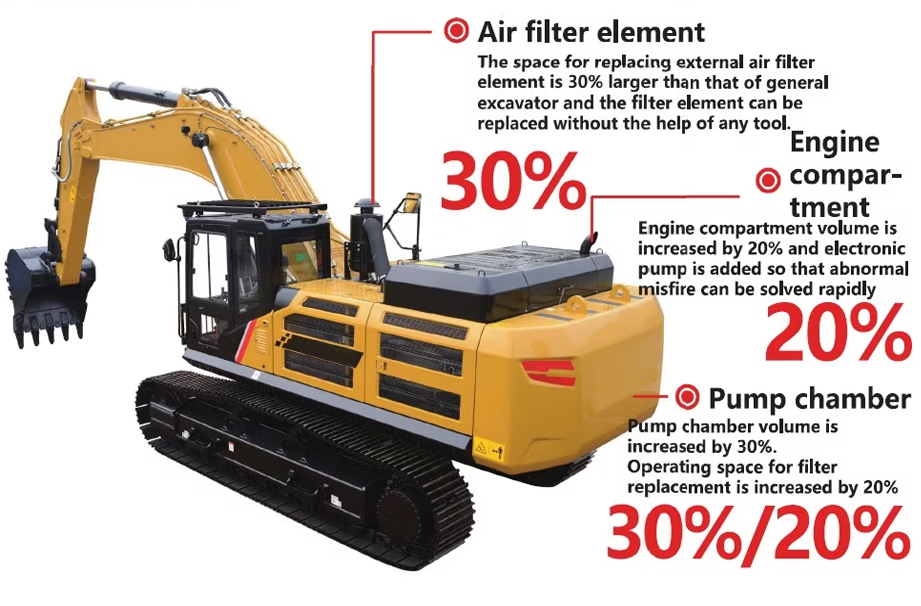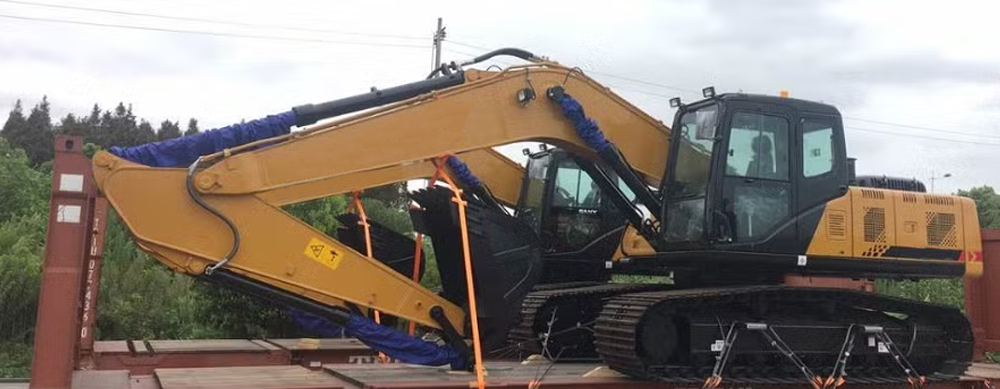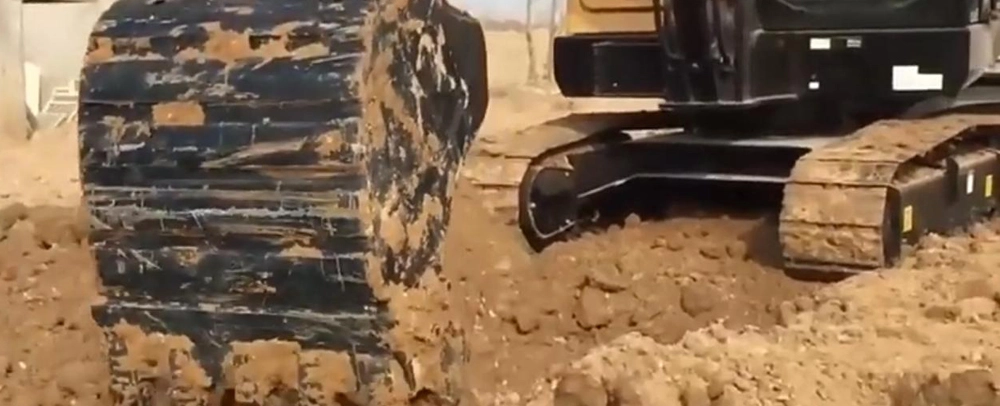Large Excavators are behemoths in the construction realm. These machines boast an imposing build, with a super-strong steel frame capable of withstanding extreme loads. Their colossal digging arms, powered by a high-performance hydraulic system, can reach astonishing depths and move vast quantities of earth, rock, or debris in a single scoop. Equipped with a mammoth diesel engine generating tremendous power, they handle the toughest terrains with ease. The operator's cab is designed for maximum comfort, providing excellent visibility and state-of-the-art controls. Ideal for mega construction projects like mining, quarrying, and large infrastructure works, they significantly boost productivity.
| Pictures |
|
|
|
|
|
| General parameters | |||||
| Model | SY375H | SY375IDS | SY415H | SY485H | SY485GLC |
| Tonnage range | Large excavator (30-50 tons) | Large excavator (30-50 tons) | Large excavator (30-50 tons) | Large excavator (30-50 tons) | Large excavator (30-50 tons) |
| Travel mode | Crawler | Crawler | Crawler | Crawler | Crawler |
| Bucket type | Backhoe | Backhoe | Backhoe | Backhoe | Backhoe |
| Application | Mine type | General purpose | Mine type | Mine type | Mine type |
| Power Type | Fuel | Fuel | Fuel | Fuel | Fuel |
| Engine (fuel) | |||||
| Type | Direct injection, 6-cylinder, 4-stroke, turbocharged intercooled, water cooled | Direct injection, 6-cylinder, 4-stroke, turbocharged intercooled, water cooled | Direct injection, 6-cylinder, 4-stroke, turbocharged intercooled, water cooled | Direct injection, 6-cylinder, 4-stroke, turbocharged intercooled, water cooled | Direct injection, 6-cylinder, 4-stroke, turbocharged intercooled, water cooled |
| Rated power (kW) | 210 | 254 | 272 | 310 | 343 |
| Rated speed (r/min) | 1900 | 1900 | 1900 | 1800 | 2100 |
| Maximum torque (N·m) | 1080 | 1526/1400 | 1525 | 2050 | 2170 |
| Total Displacement (L) | 7.79 | 8.9 | 9.7 | 15.681 | 11.8 |
| Number of cylinders (pcs) | 6 | 6 | 6 | 6 | |
| Emission standard | Euro 4 | Euro 4 | Euro 4 | Euro 4 | Euro 4 |
| Performance Parameters | |||||
| Operating weight (kg) | 37800 | 37800 | 41500 | 48500 | 48500 |
| Bucket capacity (m³) | 1.9 | 1.9 | 2.2 | 2.6 | 2.6 |
| Travel speed (high/low) (km/h) | 5/3.0 | 5.2/2.7 | 5.5/3.0 | 5.5/3.5 | 5.4/3.1 |
| Rotation speed (rpm) | 9.2 | 9.2 | 9.7 | 8 | 8 |
| Ground Specific Pressure (Kpa) | 68.8 | 68.5 | 75 | 80.42 | 87.1 |
| Climbing capacity (%) | 70 | 35 | 70 | 70 | 70 |
| Bucket digging force (kN) | 235 | 248 | 280 | 280 | |
| Movable arm length (mm) | 6500 | 7000 | 7000 | ||
| Bucket Length (mm) | 2800 | 3000 | 3000 | ||
| Maximum Traction Force (kN) | 350 | 395.6 | 350 | 350 | |
| Dimension | |||||
| L x W x H (transportation condition) (mm) | 11425×3190×3825 | 11700×3360×3825 | 12095×3360×3790 | 12095×3360×3790 | |
| Cab height (mm) | 3265 | 3265 | 3470 | 3470 | |
| Track Ground Length (mm) | 4140 | 4340 | 4415 | 4415 | |
| Overall track length (mm) | 5100 | 5320 | 5440 | 5440 | |
| Track plate width (mm) | 600 | 600 | 600 | 600 | 600 |
| Track gauge (mm) | 2590 | 2740 | 2740 | 2740 | |
| Minimum Ground Clearance (mm) | 550 | 505 | 560 | 560 | |
| Minimum Turning Radius (Front End Unit) (mm) | 4365 | 4750 | 5240 | 5240 | |
| Rear Swing Radius (mm) | 3580 | 3740 | 3765 | 3765 | |
| Scope of operation | |||||
| Maximum digging radius (mm) | 10875 | 10953 | 11860 | 11860 | |
| Maximum digging depth (mm) | 7025 | 7116 | 7370 | 7370 | |
| Maximum digging height (mm) | 9985 | 10000 | 10900 | 10900 | |
| Maximum unloading height (mm) | 6905 | 6926 | 7450 | 7450 | |
| Maximum vertical digging depth (mm) | 5125 | ||||
| Fuel Volume | |||||
| Fuel tank (L) | 620 | 620 | 620 | 750 | 750 |
| Hydraulic oil tank (L) | 380 | 380 | 513 | 420 |

1. The chassis of a large excavator is a massive, heavy-duty structure made of thick, high-strength steel plates and beams. It serves as the main support framework for the entire machine. The undercarriage is a critical component, usually consisting of heavy-duty tracks.
2. The boom of a large excavator is a huge, often telescopic structure that provides the primary vertical reach. It's constructed from high-grade steel to handle the extreme forces during digging. The arm, which is attached to the end of the boom, is also of substantial size and strength.
3. The bucket on a large excavator is a massive tool designed to handle large volumes of material. There are different types of buckets depending on the application. A large-capacity general-purpose bucket is used for scooping soil, gravel, and other loose materials.
4. The hydraulic system of a large excavator is a complex and powerful network. It consists of a high-capacity hydraulic pump, usually driven by the engine. The pump pressurizes the hydraulic fluid to very high pressures and distributes it through a network of large-diameter hoses and precision valves.
5. The cab of a large excavator provides a comfortable and well-protected space for the operator. It's equipped with an ergonomic seat to reduce fatigue during long-working hours. The controls are usually a combination of joysticks and other input devices.
6. The engine of a large excavator is a powerful diesel-powered unit. It's a large-displacement engine with high horsepower and torque output to drive the hydraulic pump and other components.

1. Digging Capacity and Reach: Analyze the specific requirements of your project. For large-scale mining or deep-foundation work, you need an excavator with a significant digging depth and reach.
2. Material Handling Volume: Consider the volume and type of materials you'll be handling. If it's a large-volume earth-moving project like a quarry or a major infrastructure site, a large-capacity bucket is essential.
3. Terrain and Working Conditions: The nature of the terrain where the excavator will operate is a vital factor.
4. Operating Weight and Stability: The weight of a large excavator is a significant consideration. A heavier machine generally provides more stability during digging and lifting operations, but it also affects transportation and site access.
5. Bucket Capacity and Compatibility: Select a bucket size that matches the volume of material you need to handle.
6. Engine Power and Efficiency: A powerful engine is a must for a large excavator. Look for high-horsepower and high-torque engines to handle heavy-duty digging and loading.
7. Power and Precision: The hydraulic system of a large excavator should be powerful enough to handle the heavy loads and large movements.
8. Reliability and Durability: Given the high-pressure and high-load environment, the hydraulic system's reliability is crucial.

Large excavators are equipped with high-horsepower engines that generate substantial torque. This enables them to handle extremely heavy-duty tasks such as excavating large amounts of earth, rock, or other materials in a short time.
The boom and arm assembly of large excavators is designed for extensive reach and depth. The boom is often telescopic and can be adjusted to various heights and angles. The arm provides the necessary horizontal reach and flexibility.
Built with a massive chassis and undercarriage, large excavators are engineered to withstand the harshest conditions. The chassis, made of thick, high-strength steel, provides a stable base for the entire machine.
The operator's cab of a large excavator is designed for operator comfort and efficient operation. It features an ergonomic seat with multiple adjustments to reduce fatigue during long-working hours.
A well-designed hydraulic system is a hallmark of large excavators. It precisely controls the movement of the boom, arm, bucket, and the rotation of the upper structure. The hydraulic pump pressurizes the fluid to high levels and distributes it through a network of hoses and valves.
Large excavators are highly compatible with a variety of attachments. In addition to different types of buckets for specific materials and tasks, they can be fitted with hydraulic breakers to break up hard rock or concrete, augers for drilling deep holes, grapples for handling large and bulky objects, and compactors for soil compaction.

